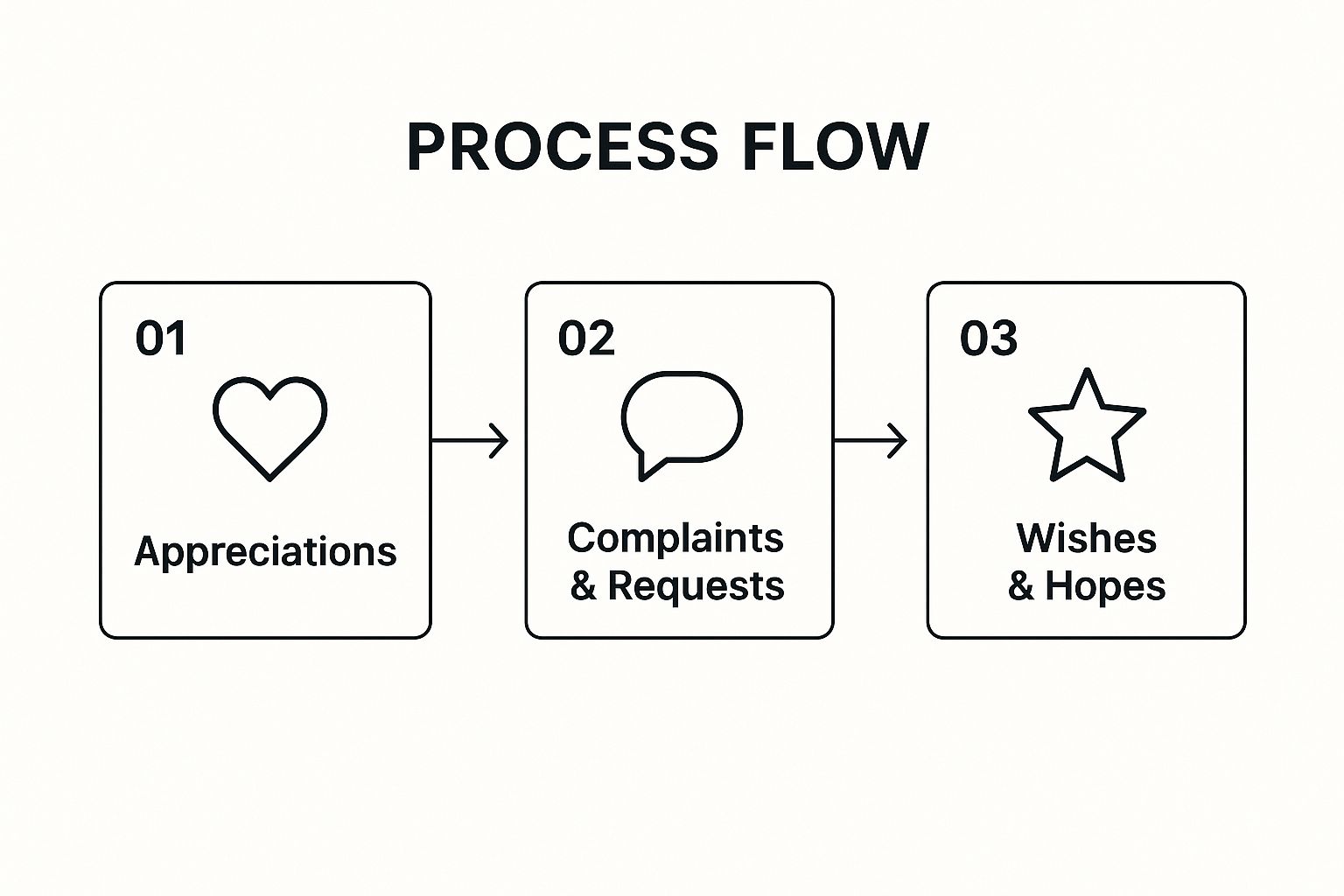Ignite Your Connection: Simple Yet Powerful Exercises
Want a deeper, more fulfilling connection with your partner? This list provides six relationship intimacy exercises to strengthen your bond and improve communication. Learn practical techniques like eye gazing, the “36 Questions That Lead to Love,” sensate focus, gratitude sharing, daily temperature readings, and the Imago Dialogue. These exercises offer powerful tools for building intimacy and fostering lasting love, whether you’re navigating challenges or simply want to enhance your relationship. Discover how intentional connection can transform your partnership.
1. Eye Gazing
Eye gazing is a powerful relationship intimacy exercise that can deepen your connection with your partner and foster a sense of vulnerability. This simple yet profound practice involves sitting face-to-face and maintaining uninterrupted eye contact for a set period, typically between 3 and 5 minutes, but anywhere from 3-10 minutes can be effective. By activating mirror neurons in the brain and facilitating nonverbal communication, eye gazing creates a unique space for intimacy and understanding, often described as ‘soul gazing.’ It’s a highly effective way to break down barriers and truly see your partner, fostering a deeper emotional bond.

This exercise deserves a top spot on any list of relationship intimacy exercises because it requires no special equipment, can be practiced anywhere private, and delivers immediate results. It’s a particularly useful tool for men in relationships who are looking to better understand their partner’s emotional world and build a stronger connection. The benefits extend beyond just feeling closer; eye gazing can increase empathy, break patterns of distraction that often plague modern relationships, and even help reconnect couples during periods of conflict.
Features and Benefits:
- Nonverbal Communication: Bypasses the limitations of words and allows for a deeper, more intuitive connection.
- Accessibility: Requires no special equipment and can be practiced in any private setting.
- Variable Duration: Can be adjusted to suit your comfort level, starting with shorter durations and gradually increasing.
- Immediate Vulnerability: Creates a space for emotional intimacy and allows partners to feel truly seen.
- Builds Deep Emotional Connection: Strengthens the bond between partners and fosters a sense of shared experience.
- Increases Empathy: Helps partners understand each other’s emotions and perspectives more deeply.
- Breaks Patterns of Distraction: Encourages focused attention on the present moment and on each other.
- Helps Partners Feel Truly ‘Seen’: Creates a sense of being understood and accepted without judgment.
- Can Reconnect Couples During Conflict: Offers a way to re-establish connection and communicate on a deeper level.
Pros and Cons:
Pros: As mentioned above, the pros include deep connection, increased empathy, breaking distraction patterns, and fostering a sense of being “seen.” It’s a powerful tool for reconnection, especially during conflict.
Cons: While incredibly beneficial, eye gazing can feel uncomfortable or awkward initially, especially for those unfamiliar with sustained eye contact. It can also bring up unexpected emotions, requiring a safe and private space for the exercise. Dedicated time is also needed, free from interruptions.
Tips for Successful Eye Gazing:
- Start Small: Begin with shorter durations (1-2 minutes) and gradually increase the time as you become more comfortable.
- Use a Timer: Set a gentle timer to avoid the distraction of checking the clock.
- Hold Hands: Try holding hands during the exercise for added connection and support.
- Low Lighting: If initial discomfort is high, practice in low lighting to soften the intensity.
- Debrief: Afterward, take some time to discuss what each partner experienced during the exercise. This can be a valuable opportunity for deeper understanding and connection.
Examples of Successful Implementation:
Eye gazing has been used for centuries in tantric practices and is implemented in modern couples therapy by Gottman-trained therapists. Relationship experts like Esther Perel also feature this exercise in workshops, highlighting its effectiveness in fostering intimacy. These examples demonstrate the widespread recognition of eye gazing as a powerful tool for building and strengthening relationships.
2. 36 Questions That Lead to Love
This relationship intimacy exercise, often referred to as “36 Questions,” offers a structured approach to building closeness and vulnerability with your partner. Developed by psychologist Arthur Aron, this method involves answering 36 increasingly personal questions, divided into three sets. These questions progress from lighthearted inquiries like “Given the choice of anyone in the world, whom would you want as a dinner guest?” to more intimate reflections such as “What is your most terrible memory?” The exercise culminates in four minutes of sustained eye contact, adding a powerful nonverbal component to the experience. This unique combination of verbal and nonverbal intimacy makes it a powerful tool for deepening connection and understanding within a relationship. This is why it earns its place on this list of top relationship intimacy exercises.
The 36 Questions exercise gained widespread recognition after being featured in a 2015 New York Times Modern Love essay by Mandy Len Catron, who recounted her experience using the questions with a university acquaintance. The experiment, initially designed to generate closeness between strangers in a research setting, unexpectedly led to Catron and her partner falling in love. Since then, the 36 Questions have been adapted for various contexts, from dating apps like Hinge to relationship retreats and workshops around the globe.
How it Works:
The exercise is designed to create a controlled environment for progressive vulnerability. Partners take turns answering each question, ensuring both individuals have equal opportunity to share and be heard. The increasing intimacy of the questions facilitates deeper self-disclosure, fostering mutual understanding and empathy. The final stage of sustained eye contact amplifies the emotional connection established through the verbal sharing.
Features and Benefits:
- Structured format: The 36 specific questions provide a clear framework for the exercise.
- Progressive intimacy: The three sets of questions gradually increase in depth, allowing for a comfortable transition into vulnerability.
- Scientifically based: Rooted in Dr. Aron’s research on interpersonal closeness.
- Versatile: Suitable for both new and established relationships.
- Combines verbal and nonverbal intimacy: The questions are paired with the powerful act of sustained eye contact.
- Helps partners discover new things about each other: Even long-term couples often find they learn something new through this exercise.
Pros and Cons:
Pros:
- Evidence-based approach
- Creates progressive vulnerability
- Helps partners discover new things about each other
- Effective for both new and established relationships
- Combines verbal and nonverbal intimacy
Cons:
- Time-intensive (typically takes 45-90 minutes)
- Some questions may feel forced for certain couples
- Effectiveness depends on honest, thoughtful answers
- May bring up sensitive topics
Tips for Successful Implementation:
- Create a comfortable and uninterrupted environment: Minimize distractions and ensure you have sufficient time to complete the exercise without rushing.
- Agree not to judge responses: Create a safe space for honest sharing.
- Allow for silence and reflection: Don’t feel pressured to fill every silence. Give yourselves time to process and consider your answers.
- Consider writing down particularly meaningful answers: This allows you to revisit and reflect on your shared experience later.
- Revisit the exercise annually: Track the evolution of your relationship and continue to deepen your understanding of one another.
By following these tips and engaging in the 36 Questions with an open mind and a willingness to be vulnerable, you can strengthen your connection with your partner and cultivate a deeper sense of intimacy within your relationship. This exercise offers a powerful pathway to understanding your partner on a more profound level and enhancing the quality of your relationship.
3. Sensate Focus
Looking for a powerful way to deepen intimacy and connection with your partner? Sensate Focus is a highly effective relationship intimacy exercise that can transform your physical relationship. Developed by renowned sex therapists Masters and Johnson, this technique deserves its place on this list because it addresses the root of many intimacy challenges by fostering mindful touch and communication. It’s particularly helpful for men seeking to truly understand their partner’s body and enhance their connection.
Sensate Focus is a structured, progressive touch exercise designed to build physical intimacy without the pressure of performance or achieving orgasm. It works by shifting the focus from goal-oriented sex to the pure sensation of touch. Partners take turns being the “giver” and the “receiver,” exploring each other’s bodies mindfully. The practice unfolds in stages, beginning with non-sexual touch, like stroking arms and legs, and gradually progressing to more intimate areas as comfort and trust increase. This deliberate, non-sexual approach allows couples to rediscover the pleasure of physical connection without the anxiety often associated with sexual performance.
Why use Sensate Focus?
This technique is invaluable for:
- Reducing performance anxiety: By removing the pressure of achieving orgasm, Sensate Focus helps men (and their partners) relax and enjoy the journey of physical connection.
- Rebuilding physical comfort: After periods of intimacy challenges, illness, or injury, Sensate Focus helps re-establish physical trust and comfort.
- Increasing body awareness and communication: This practice encourages open communication about what feels good, deepening understanding and connection between partners. It helps men understand their partner’s unique responses to touch.
- Separating pleasure from sexual outcomes: Sensate Focus highlights the inherent pleasure in touch itself, regardless of whether it leads to sexual activity.
Features and Benefits:
- Progressive stages: The structured progression allows couples to gradually build comfort and intimacy.
- Emphasis on mindfulness and sensation: The focus on being present in the moment enhances the sensory experience.
- Removes goal-oriented aspects of physical intimacy: This alleviates pressure and allows for true exploration and connection.
- Therapeutic origins: Rooted in sex therapy, Sensate Focus has a proven track record of success in addressing various intimacy issues.
Pros:
- Reduces performance anxiety
- Rebuilds physical comfort
- Increases body awareness and communication
- Separates pleasure from sexual outcomes
- Effective for addressing various intimacy issues
Cons:
- Requires significant time commitment
- Needs privacy and uninterrupted space
- May initially increase frustration for some couples if expectations are not managed
- Requires clear communication about boundaries
Examples of Successful Implementation:
- Standard practice in sex therapy for treating desire discrepancy between partners.
- Used in the treatment of sexual pain disorders.
- Implemented to rebuild connection after illness or injury affecting sexuality.
Actionable Tips for Sensate Focus:
- Create a comfortable, warm environment: Set the mood with soft lighting and comfortable temperature.
- Remove distractions including phones: Dedicate this time solely to each other.
- Use non-scented oil if desired: This can enhance the sensory experience.
- Establish clear feedback mechanisms: Use hand signals or gentle words to communicate preferences.
- Progress through stages only when both partners are comfortable: Don’t rush the process.
- Practice regularly for optimal results: Like any skill, Sensate Focus benefits from consistent practice.
Sensate Focus is a powerful tool for deepening intimacy and connection. By embracing mindful touch and open communication, couples can reignite their physical relationship and build a stronger, more fulfilling bond. It’s a relationship intimacy exercise that can truly transform your connection.
4. Gratitude Letter and Share
This powerful relationship intimacy exercise, the Gratitude Letter and Share, centers around expressing heartfelt appreciation for your partner. It involves each person composing a detailed letter to their significant other, focusing specifically on character traits, behaviors, and cherished moments that evoke gratitude. The letters are then read aloud to each other, uninterrupted, creating a shared experience of deep appreciation. This combination of written reflection and verbal affirmation can significantly boost relationship satisfaction, making it a valuable tool for couples seeking to enhance intimacy.

The Gratitude Letter and Share earns its place on this list of relationship intimacy exercises due to its multifaceted approach to fostering connection. It leverages the power of written reflection, allowing individuals to thoughtfully consider their partner’s positive qualities and contributions to the relationship. This written component creates a tangible keepsake that can be revisited in the future, serving as a reminder of the love and appreciation shared between partners. The act of sharing these letters verbally amplifies the impact, creating a moment of genuine connection and vulnerability.
This exercise is particularly effective because it counteracts the negativity bias, a common human tendency to focus on negative aspects rather than positive ones. By intentionally focusing on gratitude, couples can shift their perspective and cultivate a more positive and appreciative atmosphere in their relationship. This exercise encourages detailed observation of each other’s strengths, promoting a deeper understanding and appreciation for one another. It builds a culture of gratitude within the relationship, strengthening the bond between partners.
When and Why to Use This Approach:
The Gratitude Letter and Share can be implemented on special occasions like anniversaries or birthdays, adding a meaningful layer to the celebration. It can also be incorporated as a regular practice, perhaps monthly or quarterly, to consistently nurture gratitude within the relationship. This is especially beneficial during challenging periods when relationships may be strained. Revisiting past letters can serve as a powerful reminder of the love and connection that exists, offering a source of strength and resilience.
Tips for Successful Implementation:
- Set aside dedicated time: Allocate at least 30 minutes for writing the letter, free from distractions.
- Be specific: Instead of general compliments, focus on specific character traits, behaviors, and moments that you appreciate. For example, instead of saying “You’re kind,” you might say, “I really appreciated how you helped my mother with the groceries last week. It showed such kindness and consideration.”
- Connect to your experience: Mention how your partner’s qualities affect you personally. For example, “Your sense of humor always makes me feel lighter and more joyful.”
- Create a safe space for sharing: Ensure a distraction-free environment where you can both openly and vulnerably share your letters.
- Consider making it a ritual: Regularly practicing this exercise, even monthly or quarterly, can significantly enhance your relationship’s foundation of gratitude.
Pros:
- Counteracts negativity bias
- Creates lasting documentation of appreciation
- Encourages detailed observation of partner’s positive traits
- Can be revisited during difficult times
- Builds a culture of gratitude
Cons:
- May feel artificial if not practiced authentically
- Can be challenging during high-conflict periods
- Requires vulnerability to receive appreciation
- Writing component may be difficult for some
Examples of Successful Implementation:
- Pre-marital counseling programs
- Anniversary rituals
- Relationship enhancement programs
This exercise, popularized by figures like Dr. Martin Seligman and The Gottman Institute, is rooted in the principles of positive psychology. It leverages the power of gratitude to enhance relationship satisfaction and build stronger, more intimate connections. By actively focusing on the positive aspects of your partner and expressing your appreciation, you can create a more fulfilling and resilient relationship.
5. Daily Temperature Reading
The Daily Temperature Reading (DTR), developed by renowned family therapist Virginia Satir, is a powerful relationship intimacy exercise designed to foster open communication and strengthen emotional connection. It’s a structured conversation, a kind of relationship check-in, where partners regularly discuss five key areas: Appreciations, New Information, Puzzles (questions), Complaints with requests for change, and Wishes/Hopes/Dreams. This comprehensive approach creates a safe space for navigating difficult conversations while ensuring that positive exchanges remain a regular part of your communication. This method deserves a place on this list because it offers a practical, actionable framework for improving intimacy through consistent and honest communication.

The infographic visualizes the flow of a Daily Temperature Reading, starting with Appreciations and moving through New Information, Puzzles, Complaints, and finally, Wishes/Hopes/Dreams. The circular design emphasizes the ongoing nature of the process and the importance of revisiting these topics regularly.
The DTR process provides a clear structure for navigating potentially sensitive topics. It begins with expressing appreciation, setting a positive tone for the conversation. This flows into sharing new information, keeping each partner updated on the other’s life. Next comes the opportunity to address “puzzles”—questions or uncertainties that may be lingering. Then, complaints are aired, but crucially, they are coupled with specific requests for change, promoting solution-oriented dialogue. Finally, the DTR concludes with a focus on the future, sharing wishes, hopes, and dreams, fostering a sense of shared vision and intimacy. The sequence ensures a balance between positive affirmation and addressing challenges.
This exercise is particularly beneficial for men in relationships who may struggle with expressing emotions or navigating difficult conversations. The structured format of the DTR provides a roadmap, making it easier to broach sensitive subjects and fostering a deeper understanding of their partner’s needs and desires. It offers a practical application of intimate relationship skills. Whether you’re in a new relationship or a long-term partnership, the DTR can be a valuable tool for enhancing communication and strengthening your bond.
Features:
- Five structured components
- Regular scheduled practice (daily, weekly, or as needed)
- Balance of positive and challenging communication
- Framework for both practical and emotional sharing
- Adaptable to different time constraints
Pros:
- Prevents communication breakdowns
- Creates a reliable structure for discussing difficult topics
- Ensures appreciation remains present despite challenges
- Addresses small issues before they escalate
- Maintains emotional connection during busy periods
Cons:
- Requires consistent time commitment
- May feel mechanical until practiced regularly
- All five components are important but can be time-consuming
- Requires willingness to address concerns regularly
Examples of Successful Implementation:
- Used in family therapy for blended families
- Adapted for business partnerships
- Implemented in long-distance relationships to maintain connection
Tips for Using the Daily Temperature Reading:
- Schedule the DTR at a consistent time with minimal distractions.
- Start with appreciations to create a positive foundation.
- Keep a shared journal of topics to discuss.
- Use timers for each section if time is limited.
- Practice active listening techniques during your partner’s sharing.
- Modify the frequency based on your relationship’s needs (daily may not be necessary).
Popularized By:
- Virginia Satir
- PAIRS (Practical Application of Intimate Relationship Skills) program
- Smart Marriages movement
While the DTR requires a commitment to consistent communication, the benefits for fostering intimacy and building a stronger, more fulfilling relationship make it a valuable tool for men seeking deeper connection with their partners. By providing a framework for both positive affirmation and addressing challenges, the Daily Temperature Reading empowers couples to navigate the complexities of their relationship with greater understanding and empathy.
6. Imago Dialogue
The Imago Dialogue is a powerful relationship intimacy exercise designed to foster deep connection and understanding between partners. Developed by Drs. Harville Hendrix and Helen LaKelly Hunt, this structured communication technique helps couples break free from harmful communication patterns and create a safe space for vulnerability. It’s a key component of Imago Relationship Therapy, focusing on how childhood experiences shape our present-day relationships. By understanding these patterns, couples can heal past hurts and build a stronger, more intimate connection.

The Imago Dialogue follows a three-step process: mirroring, validation, and empathy. One partner takes the role of the “sender,” sharing their thoughts and feelings, while the other acts as the “receiver.” The receiver actively listens and then “mirrors” back what they heard, ensuring accurate understanding. Next, the receiver validates the sender’s feelings, acknowledging their emotional experience as valid, even if they don’t agree with the content. Finally, the receiver expresses empathy, demonstrating an understanding of why the sender feels the way they do, often by connecting it to their past experiences. The roles then switch, allowing both partners to experience being heard and understood.
This exercise earns its place among relationship intimacy exercises because it addresses the root causes of conflict. Instead of arguing or becoming defensive, the Imago Dialogue encourages deep listening and understanding. It moves beyond superficial agreement and delves into the underlying emotions and needs driving each partner’s behavior. This focus on empathy can be particularly helpful for men in relationships, who may sometimes struggle to fully understand and connect with their partner’s emotional world. By practicing the Imago Dialogue, men can develop stronger listening skills and create a more emotionally intimate connection with their partner.
Examples of Successful Implementation:
- Core practice in Imago Relationship Therapy: Trained therapists guide couples through the Imago Dialogue to address communication breakdowns and relationship conflicts.
- Navigating major life decisions: Couples can use this technique to discuss important decisions like career changes, finances, or family planning in a way that fosters mutual understanding and support.
- Healing after relationship betrayals: The Imago Dialogue can create a safe space for couples to process hurt, rebuild trust, and work towards forgiveness after infidelity or other betrayals.
Pros:
- Creates safety for discussing vulnerable topics
- Eliminates harmful communication patterns like defensiveness and interrupting
- Develops active listening skills
- Fosters empathy and understanding between partners
- Addresses root causes of conflict by exploring childhood patterns
Cons:
- Can feel unnatural and scripted initially
- Requires consistent practice to master
- Can be time-intensive, especially for complex issues
- May bring up difficult childhood emotions that require further processing
Tips for Using the Imago Dialogue:
- Start small: Begin with low-conflict topics to get comfortable with the process.
- Use a talking piece: A physical object, like a small ball, can help maintain structure and indicate who has the floor.
- Follow the structure: Stick to the mirroring, validation, and empathy steps until they become natural.
- Practice regularly: Don’t just use the Imago Dialogue during conflicts; incorporate it into everyday conversations to deepen connection.
- Consider professional guidance: Learning from a trained Imago therapist can be beneficial, especially in the beginning.
The Imago Dialogue is a valuable tool for anyone seeking to enhance intimacy and improve communication in their relationship. While it requires effort and practice, the benefits of deeper understanding, increased empathy, and stronger connection make it a worthwhile investment for couples looking to build a lasting and fulfilling partnership. Although there’s no specific website dedicated solely to the Imago Dialogue, information can be found through resources on Imago Relationship Therapy and books like Getting the Love You Want by Harville Hendrix and Helen LaKelly Hunt, popularized in part by Oprah Winfrey’s featuring of Imago therapy.
Relationship Intimacy Exercises Comparison
| Exercise | Implementation Complexity  |
Resource Requirements  |
Expected Outcomes  |
Ideal Use Cases  |
Key Advantages  |
|---|---|---|---|---|---|
| Eye Gazing | Low – Simple setup, requires privacy | Minimal – No equipment needed | Deep emotional connection, increased empathy | Couples seeking quick emotional bonding | Builds vulnerability & empathy; easy to do anywhere |
| 36 Questions That Lead to Love | Medium – Structured with 36 questions, requires time | Low – Just questions and quiet space | Progressive intimacy, new discoveries about partner | New or established couples wanting depth | Evidence-based; combines verbal & nonverbal intimacy |
| Sensate Focus | High – Structured stages, requires clear communication | Moderate – Privacy, comfortable space, possible materials | Reduced anxiety, improved physical intimacy | Couples facing sexual intimacy challenges | Reduces performance pressure; rebuilds physical comfort |
| Gratitude Letter and Share | Low – Writing and reading aloud | Low – Paper, quiet space | Increased relationship satisfaction, gratitude culture | All couples, especially during conflicts | Creates lasting appreciation; based on positive psychology |
| Daily Temperature Reading | Medium – Multi-component, regular schedule | Moderate – Scheduled time, possible journal | Improved communication, conflict prevention | Couples needing regular check-ins | Balanced positive & challenging communication; prevents issues |
| Imago Dialogue | High – Structured turn-taking, requires practice | Low – Comfortable setting, possibly a facilitator | Safety for vulnerable sharing, conflict resolution | Couples addressing deep conflicts | Fosters empathy & listening; addresses root relationship patterns |
Nurturing Lasting Intimacy: Your Journey Starts Now
Building deep, lasting intimacy with your partner is a continuous journey, not a destination. We’ve explored a variety of relationship intimacy exercises in this article, from the simple yet powerful act of eye gazing to the structured communication fostered by the Imago Dialogue. By incorporating practices like the 36 Questions, Sensate Focus, gratitude sharing, and daily temperature readings, you’re actively investing in a stronger, more fulfilling connection. The key takeaways here are open communication, vulnerability, and mutual respect – these are the cornerstones of any truly intimate relationship. Mastering these concepts, along with the specific relationship intimacy exercises discussed, can lead to a profound shift in your partnership, fostering deeper understanding, enhanced emotional connection, and a more satisfying intimate life.
These exercises provide a starting point; remember that consistency and genuine effort are key to seeing real results. As you embark on this journey of deeper connection, consider further enhancing your understanding and practice with the resources offered by G-Spot 101. G-Spot 101 provides comprehensive education and support for individuals and couples seeking to improve their intimate lives, offering valuable insights that complement the relationship intimacy exercises discussed here. Ready to dive deeper and unlock even greater intimacy? Visit G-Spot 101 today and explore a wealth of resources designed to empower your journey towards a more fulfilling and connected relationship.
The post 6 Relationship Intimacy Exercises for a Deeper Connection appeared first on G Spot 101 .
Intimate Tickles found this article quite interested, and we thought you might to. We give all the credit for this article to gspot. Click Here To Read This Article From It's Original Source



